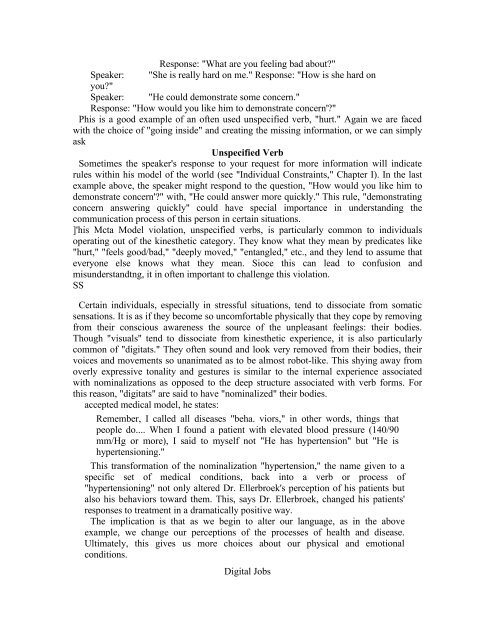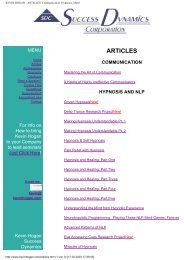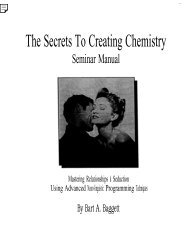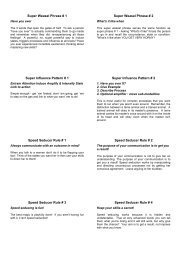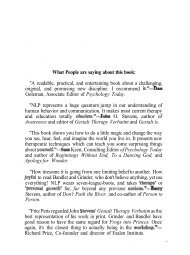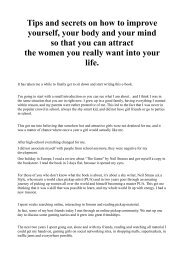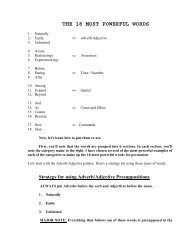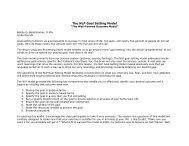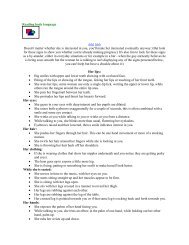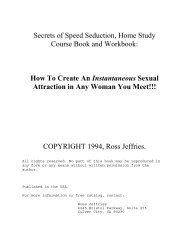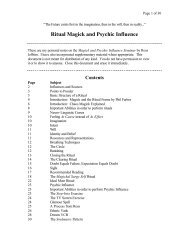A Pragmatic Guide To Communication & Change.pdf - NLP Info Centre
A Pragmatic Guide To Communication & Change.pdf - NLP Info Centre
A Pragmatic Guide To Communication & Change.pdf - NLP Info Centre
- No tags were found...
You also want an ePaper? Increase the reach of your titles
YUMPU automatically turns print PDFs into web optimized ePapers that Google loves.
Response: "What are you feeling bad about?"<br />
Speaker: "She is really hard on me." Response: "How is she hard on<br />
you?"<br />
Speaker: "He could demonstrate some concern."<br />
Response: "How would you like him to demonstrate concern'?"<br />
Phis is a good example of an often used unspecified verb, "hurt." Again we are faced<br />
with the choice of "going inside" and creating the missing information, or we can simply<br />
ask<br />
Unspecified Verb<br />
Sometimes the speaker's response to your request for more information will indicate<br />
rules within his model of the world (see "Individual Constraints," Chapter I). In the last<br />
example above, the speaker might respond to the question, "How would you like him to<br />
demonstrate concern'?" with, "He could answer more quickly." This rule, "demonstrating<br />
concern answering quickly" could have special importance in understanding the<br />
communication process of this person in certain situations.<br />
]'his Mcta Model violation, unspecified verbs, is particularly common to individuals<br />
operating out of the kinesthetic category. They know what they mean by predicates like<br />
"hurt," "feels good/bad," "deeply moved," "entangled," etc., and they lend to assume that<br />
everyone else knows what they mean. Sioce this can lead to confusion and<br />
misunderstandtng, it in often important to challenge this violation.<br />
SS<br />
Certain individuals, especially in stressful situations, tend to dissociate from somatic<br />
sensations. It is as if they become so uncomfortable physically that they cope by removing<br />
from their conscious awareness the source of the unpleasant feelings: their bodies.<br />
Though "visuals" tend to dissociate from kinesthetic experience, it is also particularly<br />
common of "digitats." They often sound and look very removed from their bodies, their<br />
voices and movements so unanimated as to be almost robot-like. This shying away from<br />
overly expressive tonality and gestures is similar to the internal experience associated<br />
with nominalizations as opposed to the deep structure associated with verb forms. For<br />
this reason, "digitats" are said to have "nominalized" their bodies.<br />
accepted medical model, he states:<br />
Remember, I called all diseases "beha. viors," in other words, things that<br />
people do.... When I found a patient with elevated blood pressure (140/90<br />
mm/Hg or more), I said to myself not "He has hypertension" but "He is<br />
hypertensioning."<br />
This transformation of the nominalization "hypertension," the name given to a<br />
specific set of medical conditions, back into a verb or process of<br />
"hypertensioning" not only altered Dr. Ellerbroek's perception of his patients but<br />
also his behaviors toward them. This, says Dr. Ellerbroek, changed his patients'<br />
responses to treatment in a dramatically positive way.<br />
The implication is that as we begin to alter our language, as in the above<br />
example, we change our perceptions of the processes of health and disease.<br />
Ultimately, this gives us more choices about our physical and emotional<br />
conditions.<br />
Digital Jobs


